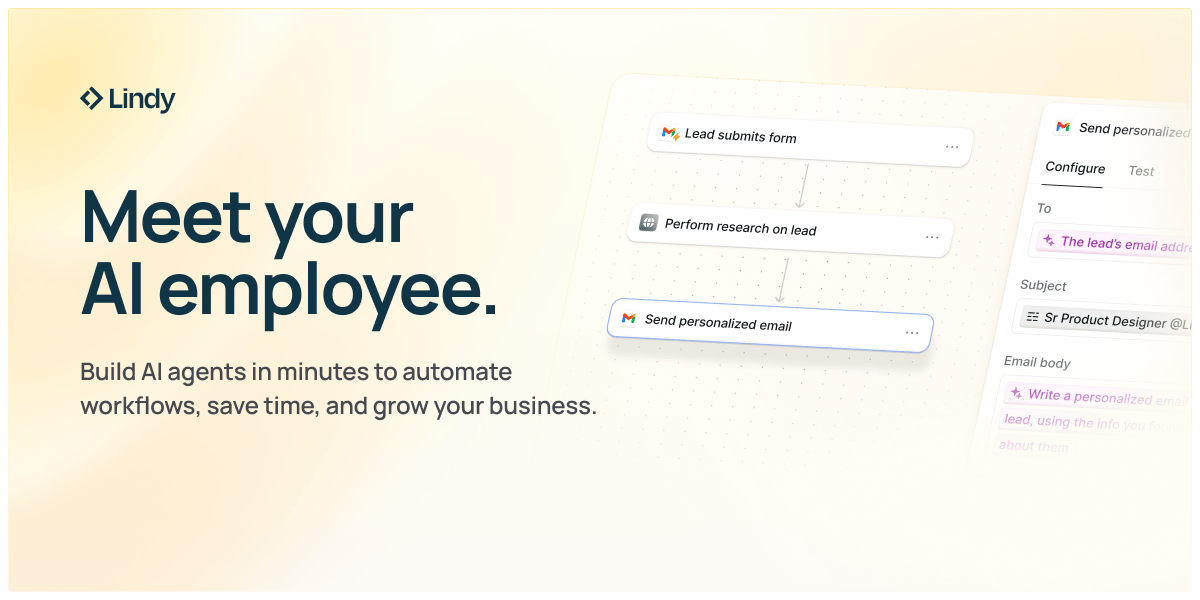- FryAI
- Posts
- U.S. Air Force lets AI take the sky
U.S. Air Force lets AI take the sky

Good morning! Looking for the most cutting-edge AI news, tools, and insights? If so, start your daily scroll. 😁
The Simplest Way to Create and Launch AI Agents and Apps
You know that AI can help you automate your work, but you just don't know how to get started.
With Lindy, you can build AI agents and apps in minutes simply by describing what you want in plain English.
From inbound lead qualification to AI-powered customer support and full-blown apps, Lindy has hundreds of agents that are ready to work for you 24/7/365.
Stop doing repetitive tasks manually. Let Lindy automate workflows, save time, and grow your business.
🤯 MYSTERY AI LINK 🤯
(The mystery link can lead to ANYTHING AI-related: tools, memes, articles, videos, and more…)
Today’s Menu
Appetizer: U.S. Air Force tests AI-piloted drones 🛩️
Entrée: Executive Order aims to use AI to fight pediatric cancer ⛑️
Dessert: Fashion brands are using AI to predict trends 💃
🔨 AI TOOLS OF THE DAY
👍 SyncTasks: A simpler way to manage your tasks. → Check it out
⛺️ Basecamp: Organize communication for your project team. → Check it out
U.S. AIR FORCE TESTS AI-PILOTED DRONES 🛩️
What’s going on? The U.S. Air Force is testing AI-piloted drones for military use.
Want the details? At Eglin Air Force Base in Florida, fighter pilots are now training alongside AI-piloted drones like the XQ-58—a program insiders are calling “Top Gun AI.” Major Trent McMullen is among the first pilots to fly with the XQ-58, a drone capable of rolling, banking, and reacting faster than a human. Using onboard AI, it learns combat maneuvers like intercepting enemy aircraft and can execute complex missions on command. The Air Force plans to expand the fleet to as many as 1,000 AI-driven aircraft by the end of the decade, each costing about a quarter of a traditional fighter jet. These drones are designed to fly ahead of manned jets, gathering data, analyzing threats, and potentially engaging in limited combat—all while human pilots monitor and can override their actions.
Why is this significant? AI copilots could revolutionize air combat, offering speed, adaptability, and lower risk in dangerous missions. As rival nations develop their own AI fleets, these smart drones may become essential for maintaining air superiority—ushering in a new era where humans and machines learn to fight side by side.
“If I can send an uncrewed asset into a high-risk environment, I’d rather do that than send a human pilot.”
EXECUTIVE ORDER AIMS TO USE AI TO FIGHT PEDIATRIC CANCER ⛑️
What happened? President Trump signed an Executive Order directing federal agencies to use AI to accelerate cures, treatments, and prevention strategies for pediatric cancer.
What does this mean? The order expands the Childhood Cancer Data Initiative (CCDI) at the National Cancer Institute, doubling its funding from $50 million to $100 million. The initiative will use AI to analyze massive sets of childhood cancer data, improving diagnosis, treatment design, and clinical trials. The Make America Healthy Again (MAHA) Commission will coordinate efforts with the Department of Health and Human Services, private sector partners, and AI experts to uncover causes and identify early risks, all while ensuring parents maintain control over their children’s health data.
Why does this matter? Pediatric cancer remains the leading cause of disease-related death among children in the U.S., with cases rising over 40% since 1975. By combining AI with national health data, researchers can find patterns invisible to humans alone—bringing faster, more precise, and more personalized treatments to the children and families who need them most.
Learn AI in 5 minutes a day
This is the easiest way for a busy person wanting to learn AI in as little time as possible:
Sign up for The Rundown AI newsletter
They send you 5-minute email updates on the latest AI news and how to use it
You learn how to become 2x more productive by leveraging AI
FASHION BRANDS ARE USING AI TO PREDICT TRENDS 💃
What’s up? Fashion brands are now using AI to predict what styles people will want to wear next.
How does it work? AI scans massive amounts of data from social media—from TikTok videos and Instagram posts to runway photos—to spot early signs of new trends. For example, if the color yellow starts popping up more often online, the system flags it as a possible upcoming trend. At companies like Stitch Fix, designers can even use AI to instantly generate realistic images of new clothing ideas, like seeing how a shirt would look in blue versus red, before spending money to make samples.
Why does this matter? Fashion moves faster than ever, and AI helps brands predict demand, reduce waste, and get new looks to market quickly. Still, experts say human taste remains vital—while AI can spot trends, only people can tell what truly inspires us to wear them.
HAS AI REACHED SINGULARITY? CHECK OUT THE FRY METER BELOW:
What do ya think of this latest newsletter? |
Your feedback on these daily polls helps us keep the newsletter fresh—so keep it coming!





